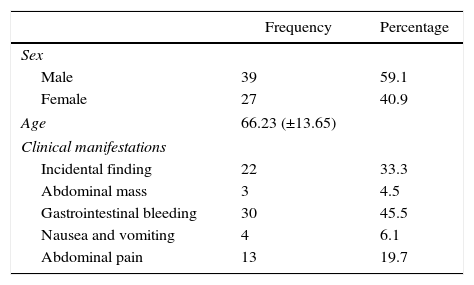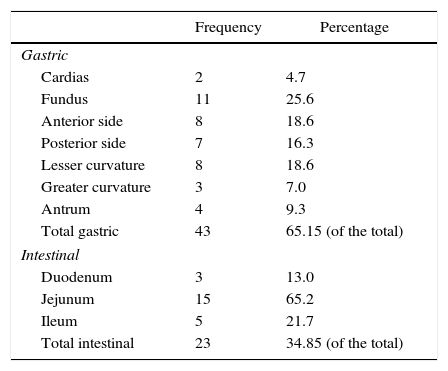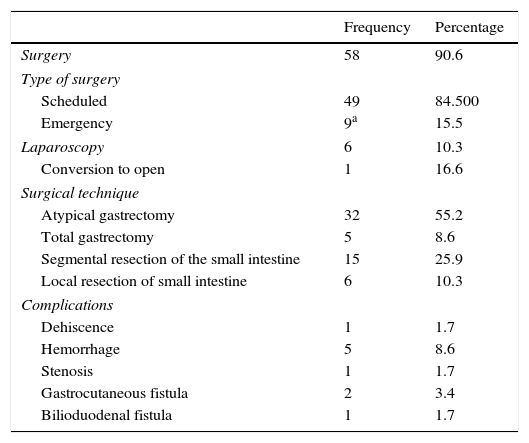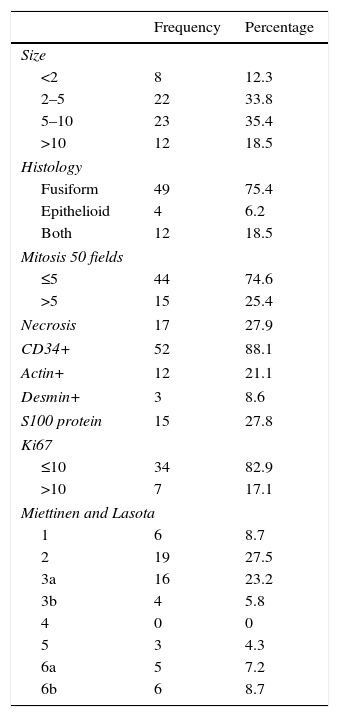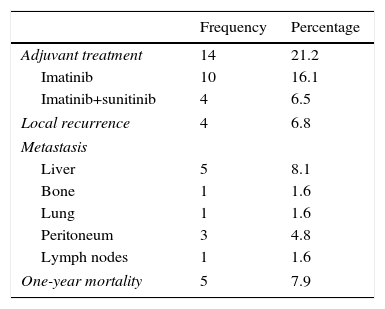This study was aimed to assess the main clinical, pathological and therapeutic characteristics of a cohort of gastrointestinal stromal tumors (GIST).
MethodsObservational study including 66 patients diagnosed with GIST admitted to our hospital between 2002 and 2015. Parameters related to medical history, clinical manifestations, medical and surgical treatment, histopathology, and morbi-mortality were studied. A review of the literature was included to correlate with the results.
ResultsThe most frequent location of GIST in our patients was the stomach (65.2%), in which the gastric fondo was the predominant region. The most common clinical manifestation was gastrointestinal hemorrhage (45.5%), followed by incidental finding after imaging or invasive procedures (33.3%). 58 patients underwent surgery (90.6%), 15.5% were urgent. A total of 69% of the GISTs had a size between 2 and 10cm. The one-year mortality was 7.9%, all cases related to local or remote extension, or surgical complications.
ConclusionThere is a large clinical variability among GIST cases. The first choice of treatment is surgery, which is feasible in most cases and should be as conservative as possible. The prognosis varies depending on the size and proliferation index, thus close follow-up should be performed. No tumor marker is clearly associated with a poor prognosis. New molecular biology studies are needed in order to find therapeutic targets.
Describir las principales características clínicas, anatomopatológicas, terapéuticas y evolutivas de una serie amplia de tumores estromales gastrointestinales (GIST).
MétodosEstudio observacional de una serie de 66 casos de GIST tratados en nuestro hospital de 2002 a 2015. Seleccionamos variables relacionadas con los antecedentes personales, las manifestaciones clínicas, el tratamiento médico y quirúrgico, la anatomía patológica y la morbimortalidad. Añadimos una revisión de la literatura para correlacionarla con nuestros resultados.
ResultadosLa localización más frecuente fue el estómago (65,2%), en el que destacó como región predominante el fondo. La manifestación clínica más habitual fue la hemorragia digestiva (45,5%), seguida del hallazgo casual tras la realización de alguna prueba de imagen o procedimiento invasivo (33,3%). Recibieron cirugía 58 pacientes (90,6%), el 15,5% de carácter urgente. El 69% de los GIST tenían un tamaño entre 2 y 10cm. La mortalidad al año debida al tumor fue de un 7,9% (5 casos), todos ellos relacionados con extensión local o a distancia, o complicación quirúrgica.
ConclusionesLa variabilidad clínica de los GIST es muy amplia. El tratamiento de primera elección es la cirugía, que es factible en la mayoría de los casos y debe ser lo más conservadora posible. El pronóstico es variable, dependiendo del tamaño y del índice de proliferación, por lo que debe realizarse un seguimiento estrecho. No existe un marcador tumoral claramente asociado a un peor pronóstico, por lo que se necesitan nuevos estudios de biología molecular con el objetivo de encontrar dianas terapéuticas.






